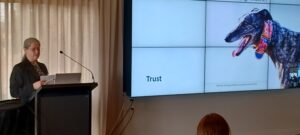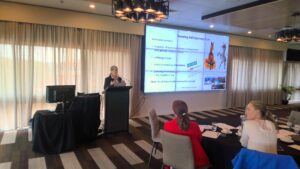Safeguarding horses and greyhounds for better racing experiences
Animal care in racing is moving towards a greater understanding of what physical and mental wellbeing means for racehorses and greyhounds – and meeting those needs.
For people enjoying the racing experience at Ascot, the focus may be fashion, hospitality and a good vantage point to see the track but equestrian authority Julie Fielder turned the experience to the animal point of view at the welfare forum held at the racecourse today.
Julie, a University of Melbourne Veterinary School PhD candidate, said wider acceptance that animals were sentient and could feel, engage with their surroundings and have good or bad experiences had changed attitudes to welfare.
“Talking about animal emotions, feelings or mental state is tricky,” she said.
“Historically, in most animal-related activities, people have avoided referring to the animal’s emotional state.
“The reasons include the risk of anthropomorphism, or projecting human characteristics onto animals, as well as the lack of step-by-step guides for making evidence-based inferences about the animal’s mental state.”

Julie, a guest speaker at Racing and Wagering Western Australia’s racehorse and greyhound welfare forums, has worked between the horse industry and government for 20 years as Horse SA Executive Officer as well as roles with Riding for the Disabled and TAFE.
She described the welfare aim of providing ‘a good life’ for animals, which goes beyond avoiding negative experiences to encouraging positive ones. Animal welfare can be evaluated by a five-point scale:
- A good life: Balance is strongly positive. Full compliance with best practice recommendations well above minimum standards.
- A life worth living: Positive but less so, full compliance with minimum standards, including significant enrichments.
- Point of balance: Neutral.
- A life worth avoiding: Negative but can be remedied quickly with vet treatment or changes to husbandry.
- A life not worth living: Negative with euthanasia the only humane alternative.

Julie Fielder
The welfare approach includes factors such as interaction between humans and animals as well agency, which refers to the animal’s ability to make choices to fulfill their needs.
At a racetrack, animal agency is affected by the highly managed location and schedule as well as reliance on people for their care – but options are still available in racing situations.
“The future of animal welfare is about working together to provide better than basic care for all animals connected with racing,” Julie said.
“It means a shift from previous welfare approaches of simply preventing suffering and cruelty to actively anticipating the essentials for an animal’s physical and mental well-being and providing them.
“There are wider implications because the people making decisions about welfare and everyone who interacts with the animal together contribute to their well-being.
“This active, collaborative model of care is known as safeguarding.”

At the races, the people who can influence an animal’s experience range from trainers, stewards, vets and welfare officers to club committees, venue managers and the public.
In a racecourse environment, Julie noted several safeguarding principles.
“An organisation-wide approach to promoting welfare culture and continuous improvements for animals and people is important,” she said.
“Welfare-related practices should be matched with an evidence-based animal welfare plan.
“Care is a collaborative effort and decisions are made which balance the situation and people.
“Finally, being accountable and transparent is important for public trust.”
Susan de Ruyter

